| Day 371 |
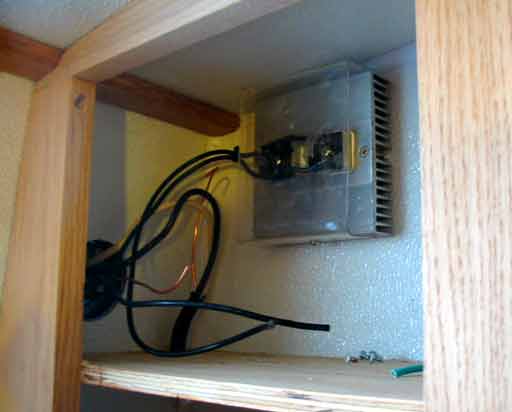 |
Shore Power |
| The shore power plug has been
todays issue. The whole idea of shore power is to be able to
conveniently charge batteries, use appliances one normally wouldn't use
while at sea because of amperage draw, and be able to plug in safely.
One thing we didn't consider is that 80% of the world runs on 220/230
VAC 50 hertz! A simple rectifier style "buzz box" should solve this problem taking the voltage down to 110 to 120 VAC at 50 hertz. Unfortunately the plugs are all different and this method creates RF noise and is hard on some appliances combined with the lower 50 hertz line frequency. |
||
|
We have thought about using a 220 VAC to
120 VAC transformer, but these are large and heavy and still have 50 hz
coming out. There is also the option of a proper 50 hz battery charger (
our Zantrac isn't switchable to 220VAC if you can believe it! ) on a
separte Euro-style socket, then running anything 120VAC through the
inverter. This would be somewhat limiting, but would work. We still
haven't decided what to do yet at this point. As can be seen below, the plugs are ground
fault protected, a good idea in a marine environment. These should work
in tandem with the boat ground but one never knows until it it tried. I
doubt the galvanic isolator would have any affect as long as the grounds
are connected on the boat side. |
 |
|

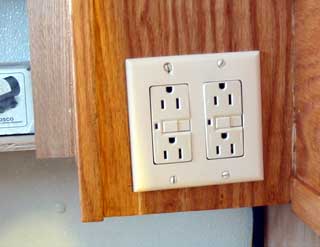 |
 |
|
| In addition to the above, a galvanic
isolator must be incorporated into the ground so there is no
electrolysis between the marina ground and the boat ground. While
commercially available, we decided to make our own. Gena put it together
and I did the wiring. ( Diagram above)
2 full wave 30 amp rectifier bridges make
up the 1.2 volt isolation required. Each must be connected positive to
negative to allow AC current flow in the event of a short to ground, and
must be of sufficient amperage to handle the plug current long enough to
throw a breaker. Each shore power plug is a different configuration to
make amperage limits "idiot-proof". Ours is a 30 amp plug, so the
isolator must handle at least 30 amps. Each rectifier in these bridges
can handle 30 amps, so in parallel they make 60 amps. Well within the
safety zone. The standard method in purchased units is 2
rectifiers one way, 2 the other. |
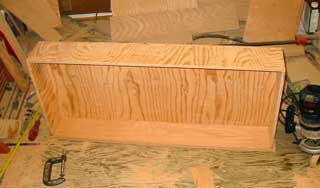 |
|
| The tiny breaker box has a
main, and a secondary for the charger, then another for the in-house
direct power ( which may be only at the plug in the galley considering
the above paragraph! ) The inverter power will go forward to my desk,
aft to the berth ( in case we would like an electric blanket! ) and
possibly a razor plug in the head, for any guys that may be aboard. The whole electrical system will be covered in upcoming days, once we have decided what to do.
Above right, I managed to make the center drawer for my desk finally! If it looks big that's because it is, 38" wide, just big enough to house, say, something as large as my Kawai keyboards for example. Because of the size and function of this drawer ( everyone will get a kick out of the final product I assure you! ) some special considerations must be made. More in the next couple of days... |
||
|
||
| The "roll top" style galley
lockers were the other order on today's menu. Now the smaller one is
finished I can "push" them into place. |
||
 |
I say "push" as they were really tight to
get in. The large one actually required the stove to be tilted back on
it's gimbals to allow it to pass! It feels sort of good when something fits so well that one only screws it into place as a formality. Ha ha! Something is still missing at the top. The "head plates" will cover the holes. These I left until last as they must grow as one moves to the bow. The inward slope allows plenty of counter space as predicted. Just as a note, the reason one tambour is higher than the other is just because when I split it, there was an odd number of slats. A test piece of foam under the taller one makes it look even higher, so don't worry, nothing wrong with this girls' eyes! |
|
.
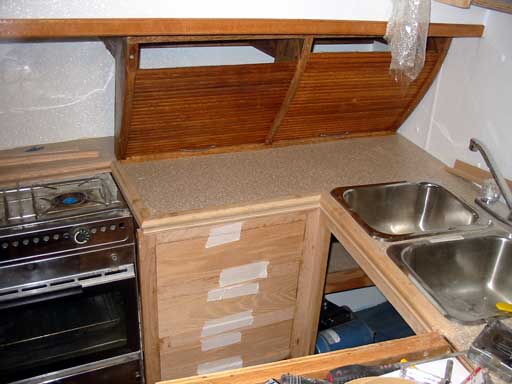
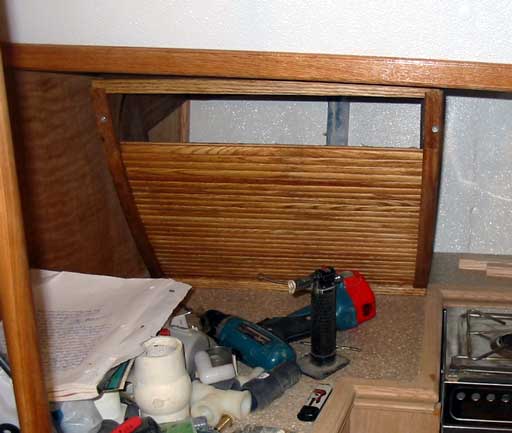
Wow ! Lookin' finished...almost
Day 371:
9 hours: Put in galley cupboards under the deck, ran in shore power
wiring.